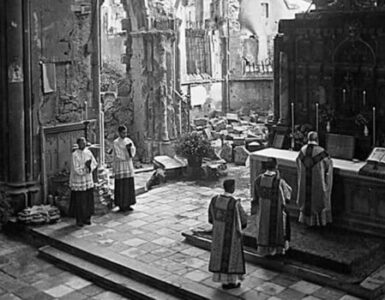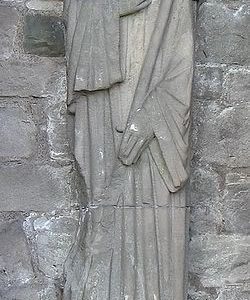In the same century that St. Malachy wrote his cryptic predictions of history’s remaining popes, Cistercian abbot Joachim di Fiore put down his own mystical prophecies concerning future popes and the end of time.
Born in the southern Italian village of Celico c. 1135, he rose to prominence as a mystic and counselor, counting Queen Constance of Sicily and King Richard the Lionheart among those who sought his counsel. He lived as a Cistercian before founding the Abbey of San Giovanni di Fiore, which was abandoned after his death.
Readers can now access Joachim di Fiore’s prophecies for the first time in English, collected in a slim illustrated volume edited by Fr. Robert Nixon, OSB (Sensus Fidelium Press, 2023).
Di Fiore’s works were disputed— his writings on the Trinity were declared heterodox by the Fourth Lateran Council— and his prophecies are a mixed bag. He believed the world would end in the year 1260, yet he accurately predicted the rise of the Dominican and Franciscan orders, which were founded in the century following his death in 1202. He has not yet attained an official beatification, though he popularly is referred to as “Blessed.” Dante Alighieri places him in Heaven, speaking to his enduring cultural influence.
Relying on the theory of the three ages of human history, di Fiore’s writings assume a swiftly approaching apocalypse.
The Age of the Father characterized the Old Testament. The Age of the Son references the life of Jesus and the establishment of the New Covenant. The Age of the Holy Spirit encompasses the rest of human history, from the Ascension until the Apocalypse. We are necessarily living in this third age—and to di Fiore, the immediacy of this trajectory took precedence in his interpretation of Church events and short future.
The book consists of di Fiore’s 30 prophecies, or “oracles” concerning the popes, buttressed by his prophecies on the Dominican and Franciscan orders, and rounded out by his interpretation of the number of the beast in the Book of Revelation. Appendices include a 17th century image providing a cyclic interpretation of the oracles, and the 16th century papal prophecies of Bl. Giodcocho Palmerio.
Readers who hope to draw clear parallels to known pontiffs will likely be disappointed, as the prophecies are almost entirely inscrutable. The editor does not interpret or elaborate upon the specific prophecies, leaving that task to the reader. He recognizes the perplexing nature of the prophecies, stating: “Whereas identifying the popes referred to in the probably non-genuine prophecies attributed to St. Malachy is a relatively straightforward task, understanding the prophetic utterances attributed to Blessed Joachim is far from simple (as any aspiring interpreter of them will very soon discover!) Nevertheless, it is the hope of the translator that modern readers may find these mystical oracles, despite their obscurity and ambiguity, to be beautiful, striking, and thought-provoking.”
My attempts to understand the prophecies got me nowhere, but I did notice several emergent themes.
First, the apocalyptic nature of the writings is evident: for example, Oracle XV states “This is the final beast, terrible in aspect, who shall draw down the Stars from the Heavens,” using cosmic and final language reminiscent of the Book of Revelation.
Second, the succession of popes fluctuates between the good, the bad, and the conflicted. “Fraudulently you have entered, powerfully you have ruled. But weeping, you shall die!” (Oracle VI) suggests a corrupt leader, while the virtues of the pope in Oracle XVI are praised: “A good work! He shall bestow a treasury upon the poor.” Some reigns are not so straightforward: Oracle XXVIII celebrates the illustrious “second life” of a man from a prominent family, but prognosticates that “after just two years, he shall enter the rock again, dead.” The distinction between pope and antipope is not made, leaving much to retrospective speculation.
Third, the author references familiar figures to emphasize the future popes’ characteristics. Nero makes several appearances, representing a type of the Antichrist. Simon the Magus is mentioned as a current adversary, possibly alluding to the rise of various forms of Gnosticism in the Middle Ages. Di Fiore also makes use of popular allegorical imagery: the dove, the fox, and the she-bear are frequently-used devices, delineating the various shades of virtue, vice, and duplicity.
Another interesting element of the book is the reproduction of original sketches that accompany each prophecy. As the editor notes, the images are not merely supplementary, but are integral parts of each prophecy. They are striking depictions of each pope in question, replete with symbology and always wearing the unmistakable papal tiara.
Altogether, this volume is a fascinating primary source from a relatively unknown abbot in an obscure period, made accessible to a new generation of Catholics who are often given reason to meditate on the role of the papacy. It may not contain many direct answers, but it will be valuable for researchers of the medieval Church and apocalyptic prophecy.
The Papal Prophecies of Bl. Joachim di Fiore is available from Sensus Fidelium Press.
Image by Alberto Masnovo on Shutterstock












